Words and Characters¶
Notes about character-level markup in USFM:
Elements in this section mark portions of text within a larger paragraph unit. This type of element is often referred to generically as a character style, where the larger containing text units are often referred to as paragraph styles. In the case of a text markup scheme like USFM, the term “style” is somewhat misleading, in that the essential goal of USFM it to mark common scriptural element types, and not formatting information. Bearing that in mind, USFM has also inherited and attempted to unify a long history of SFM type scripture markup “standards”, some of which were more or less strict in their tolerance for format-oriented markers. We have not wished to create an unworkable migration task for legacy SFM encoded texts.
Translation editing software which implement support for USFM encoded text may provide a formatted view of the text using a set of style definitions for each USFM marker. These “stylesheets” most often refer to the formatting definitions as paragraph and character styles.
Note
About nesting character level markup in USFM (>2.4): USFM 2.4 adds a new syntax for indicating that a nesting of one character level marker within another is taking place within a text. See Character Marker Nesting for details.
Special Text¶
\add …\add*¶
- Syntax
\add_text...\add*- Type
character
- Added
1.0
- Use
Translator’s addition.
A translator’s explanation; words added by the translator for clarity – text which is not literally a part of the original language, but which was supplied to make the meaning of the original clear.
Text and Formatting Sample - Genesis 5.29 (Russian Synodal, Protestant Version)
\p
\v 29 И нарек ему имя: Ной, сказав: он утешит нас в работе нашей и в трудах рук
наших при \add возделывании\add* земли, которую проклял Господь.

\bk …\bk*¶
- Syntax
\bk_text...\bk*- Type
character
- Added
1.0
- Use
Quoted book title.
Text and Formatting Sample - Introduction to Mark (GNT)
\mt1 THE ACTS
\mt2 of the Apostles
\is Introduction
\ip \bk The Acts of the Apostles\bk* is a continuation of \bk The Gospel according
to Luke\bk* Its chief purpose is to tell how Jesus' early followers, led by the Holy
Spirit, spread the Good News about him “in Jerusalem, in all of Judea and Samaria,
and to the ends of the earth” (1.8).
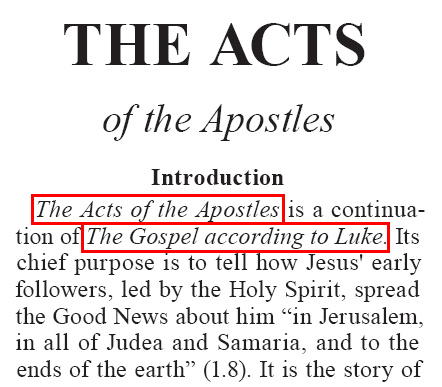
\dc …\dc*¶
- Syntax
\dc_text...\dc*- Type
character
- Added
1.0
- Use
Deuterocanonical/LXX additions or insertions in the Protocanonical text.
General purpose use of\dc ...\dc*or nested\+dc ...\+dc*is encouraged wherever DC-only content is being marked. Use of context-specific DC-only markup (i.e. \fdc …\fdc*, \xdc …\xdc*) is discouraged.
Text and Formatting Samples - Hebrews 1.3 (Spanish DHE - footnote)
\v 3 Él es el resplandor glorioso de Dios,\f c \fr 1.3: \fk Resplandor: \ft Cf.
Jn 1.4-9,14\+dc ; también Sab 7.25-26, donde algo parecido se dice de la sabiduría\+dc*.\f*
la imagen misma de lo que Dios es y el que sostiene todas las cosas con su palabra
poderosa. Después de limpiarnos de nuestros pecados, se ha sentado en el cielo, a la
derecha del trono de Dios,
\v 4 y ha llegado a ser superior a los ángeles, pues ha recibido en herencia un título
mucho más importante que el de ellos.
Psalm 115.3-4 (GNT - cross references)
\q1
\v 3 Our God is in heaven;
\q2 he does whatever he wishes.
\q1
\v 4 \x - \xo 115.4-8: \xt Ps 135.15-18; \+dc Ltj Jr 4-73; \+dc*\xt Rev 9.20.\x* Their
gods are made of silver and gold,
\q2 formed by human hands.
1 Corinthians 15.51-52 (GNT - cross reference)
\p
\v 51-52 \x - \xo 15.51,52: \xt \+dc 2Es 6.23; \+dc*1Th 4.15-17.\x* Listen to this secret
truth: we shall not all die, but when the last trumpet sounds, we shall all be changed
in an instant, as quickly as the blinking of an eye. For when the trumpet sounds, the
dead will be raised, never to die again, and we shall all be changed.
\lit¶
- Syntax
\lit_text...- Type
paragraph
- Added
1.0
- Use
Liturgical note/comment. (e.g. a guide which tells the reader/worshipper that he should recite a prayer or recitation etc.)
A paragraph style.
Text and Formatting Sample - Psalm 3 (Russian Synodal, Orthodox Version)
\c 3
\d
\v 1 Псалом Давида, когда он бежал от Авессалома, сына своего.
\p
\v 2 Господи! как умножились враги мои! Многие восстают на меня;
\v 3 многие говорят душе моей: «нет ему спасения в Боге».
\v 4 Но Ты, Господи, щит предо мною, слава моя, и Ты возносишь голову мою.
\v 5 Гласом моим взываю к Господу, и Он слышит меня со святой горы Своей.
\v 6 Ложусь я, сплю и встаю, ибо Господь защищает меня.
\v 7 Не убоюсь тем народа, которые со всех сторон ополчились на меня.
\v 8 Восстань, Господи! спаси меня, Боже мой! ибо Ты поражаешь в ланиту всех врагов
моих; сокрушаешь зубы нечестивых.
\v 9 От Господа спасение. Над народом Твоим благословение Твое.
\lit Слава:
Слава: = “Glory”.
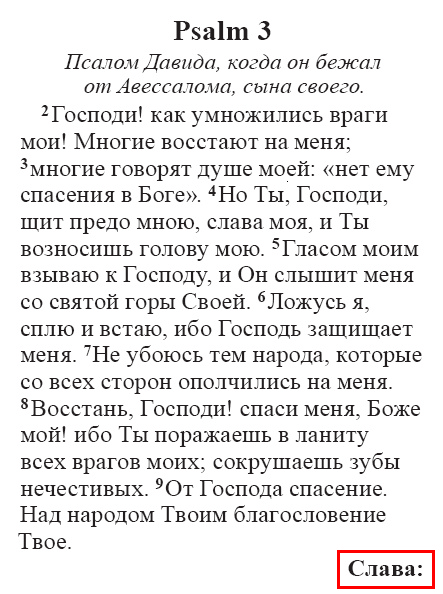
\nd …\nd*¶
- Syntax
\nd_text...\nd*- Type
character
- Added
1.0
- Use
Name of God (name of Deity).
Text and Formatting Sample - Exodus 3.15 (GNT)
\p
\v 14 God said, “I am who I am. You must tell them: ‘The one who is called I AM has
sent me to you.’
\v 15 Tell the Israelites that I, the \nd Lord\nd*, the God of their ancestors, the God
of Abraham, Isaac, and Jacob, have sent you to them. This is my name forever; this is
what all future generations are to call me.
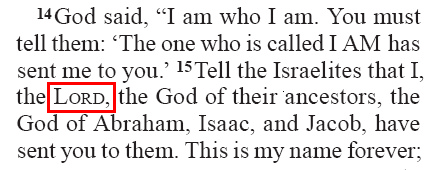
\ord …\ord*¶
- Syntax
\ord_text...\ord*- Type
character
- Added
1.0
- Use
Ordinal number ending (i.e. in “1st” — 1\ord st\ord*).
\png …\png*¶
- Syntax
\png_text...\png*- Type
character
- Added
3.0
- Use
Geographic proper name.
Particularly in China, there are various groups which have the practice of distinguishing visually between proper names of people and proper names of geographic places in published texts. Published materials may use a single underline to present proper names of people, and double underline to present proper names of geographic places. Alternatively, dotted underlines have been used for geographic proper names.
Special presentation for names can assist readers to know what the text means, especially readers who may struggle with reading skills and may be overloaded by the transliterated names.
\addpn …\addpn*¶
- Syntax
\addpn_text...\addpn*- Type
character
- Added
2.0
- Deprecated
3.0
- Use
Support for overlapping \pn …\pn* and \add …\add* occurrences in Chinese texts.
Deprecated (use is discouraged).
 Recommended alternate: Nested \pn …\pn* within \add …\add*.
Recommended alternate: Nested \pn …\pn* within \add …\add*.
\qt …\qt*¶
- Syntax
\qt_text...\qt*- Type
character
- Added
1.0
- Use
Quoted text.
Old Testament quotations in the New Testament, or other quotations.
Text and Formatting Samples
Poetic format, where all text is a quotation.
\q1 \qt ........................................\qt*
\q2 \qt ........................................\qt*
\q1 \qt ........................................\qt*
\q2 \qt ........................................\qt*
Poetic format, where text is mixed (only some is a quotation).
\q1 \qt ...............\qt* ..............\qt ........\qt*
\q2 \qt .....\qt* ................................
\q1 ..................................................
\q2 \qt.........................................\qt*
Mark 1.2-3 (GNT)
\p
\v 1 This is the Good News about Jesus Christ, the Son of God.
\v 2 It began as the prophet Isaiah had written:
\q1 \qt “God said, ‘I will send my messenger ahead of you\qt*
\q2 \qt to open the way for you.’\qt*
\q1
\v 3 \qt Someone is shouting in the desert,\qt*
\q2 \qt ‘Get the road ready for the Lord;\qt*
\q2 \qt make a straight path for him to travel!’ ”\qt*
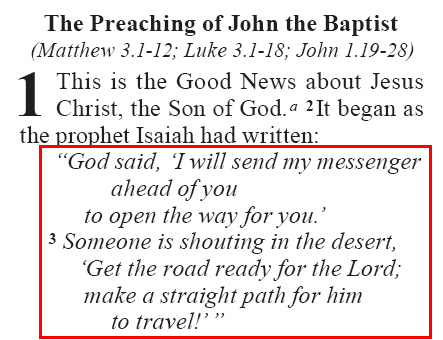
\sig …\sig*¶
- Syntax
\sig_text...\sig*- Type
character
- Added
1.0
- Use
Signature of the author (of a letter or epistle).
Text and Formatting Sample - Colossians 4.18 (GNT)
\p
\v 18 With my own hand I write this: \sig Greetings from Paul\sig*. Do not forget
my chains!
\cls May God's grace be with you.

\sls …\sls*¶
- Syntax
\sls_text...\sls*- Type
character
- Added
1.0
- Use
Passage of text based on a secondary language or alternate text source.
E.g. The French NBS02 has large sections of text in EZR and DAN in italics, to represent where the original text is in Aramaic, not Hebrew.
Text and Formatting Sample - Ezra 4.8—6.18 (NBS - French, Nouvelle Bible Segond)
\v 7 Et aux jours d'Artaxerxès, Bishlam, Mitredath, Tabéel et le reste de leurs
collègues écrivirent à Artaxerxès, roi de Perse. Le texte de la lettre fut écrit en
araméen, traduit en araméen.
\p
\v 8 \sls Rehoum, chancelier, et Shimshaï, secrétaire, écrivirent au roi Artaxerxès
la lettre suivante concernant Jérusalem, savoir:\sls*
\v 9 \sls «Rehoum, chancelier, Shimshaï, secrétaire, et le reste de leurs collègues,
ceux de Dîn, d'Apharsatak, de Tarpel, d'Apharas, d'Erek, de Babylone, de Suse, de Déha,
d'Elam,\sls*
...
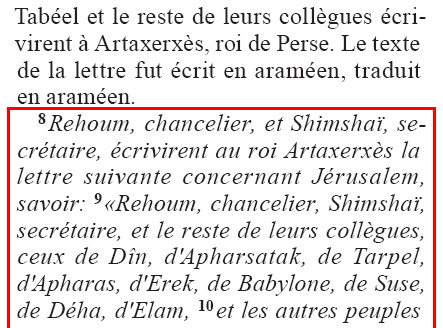
\tl …\tl*¶
- Syntax
\tl_text...\tl*- Type
character
- Added
1.0
- Use
Transliterated (or foreign) word(s).
Text and Formatting Sample - Matthew 27.46 (GNT)
\s1 The Death of Jesus
\r (Mark 15.33-41; Luke 23.44-49; John 19.28-30)
\p
\v 45 At noon the whole country was covered with darkness, which lasted for three hours.
\v 46 At about three o'clock Jesus cried out with a loud shout, \tl “Eli, Eli, lema
sabachthani?”\tl* which means, “My God, my God, why did you abandon me?”
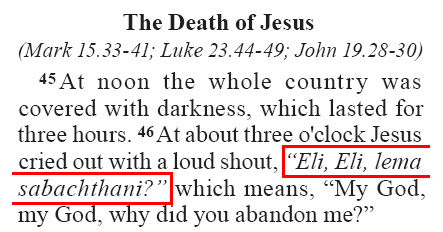
\wj …\wj*¶
- Syntax
\wj_text...\wj*- Type
character
- Added
2.0
- Use
Words of Jesus.
Character Styling¶
Warning
Note: The use of formatting oriented character markup is strongly discouraged. Please search for the appropriate USFM element to markup content, wherever possible.
\no …\no*¶
- Syntax
\no_text...\no*- Type
character
- Added
1.0
- Use
Normal text.
May be used when a larger paragraph element is set in an alternate font style (e.g. italic), and a selected section of text should be displayed in normal text.
\sup …\sup*¶
- Syntax
\sup_text...\sup*- Type
character
- Added
3.0
- Use
Superscript text. Typically for use in critical edition footnotes.
Spacing and Breaks¶
~¶
- Syntax
~- Type
character
- Added
1.0
- Use
No-break space.
c.f. Unicode character U+00AO (NO-BREAK SPACE)
//¶
- Syntax
//- Type
character
- Added
1.0
- Use
Discretionary (optional) line break.
Primarily used in poetic text, but could also be used for marking optional breaks for titles, headings, or table cell content breaks.
Text and Formatting Sample - Matthew 9.1 (GNT)
\c 9
\s1 Jesus Heals a Man // Who Could Not Walk
\r (Mark 2.1-12; Luke 5.17-26)
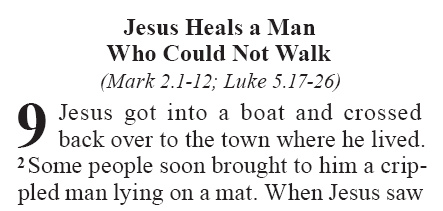
\pb¶
- Syntax
\pb- Type
paragraph
- Added
1.0
- Use
Explicit page break.
Special Features¶
\fig …\fig*¶
- Syntax
\fig_caption text...|src="filename" size="size" ref="reference"\fig*- Type
paragraph
- Added
1.0
- Updated
3.0 (attributes)
- Use
For defining illustrations to be used within a publication.
Caution
Significant syntax change from USFM 1.x / 2.x
The syntax for defining illustrations in USFM 3.0 follows the general syntax for providing word level attributes. In USFM 1.x and 2.x, markup for illustrations required a the content for a collection of parameters to be provided in a specific order, with items separated by a vertical bar (e.g \fig_DESC|FILE|SIZE|LOC|COPY|CAP|REF\fig*). The use of marker attributes, and the use of a vertical bar as an attribute separator was unique to illustration markup in USFM 1.x and 2.x. In USFM 3.0 this syntax is deprecated in order to align the markup with the general syntax for word level attributes.
Following the syntax for word level attributes. Required attributes are indicated in the list below with a red asterisk *.
Multiple attributes are required. There is no single, un-named default.
Compatibility with USFM 1.x and 2.x: If a USFM parser encounters a list of un-named attributes using a vertical bar separator within
\fig ...\fig*these should be interpreted according to the strict USFM 2.x order.
- alt
Short, free-form description of image
- src
* Filename
- size
* Illustration relative size. Options are
col(illustration should be inserted inline within the current text column) orspan(illustration should be inserted across - “spanning” - text columns)- loc
Location / range. Specify a range of references at which the illustration might be inserted.
- copy
Rights holder / copyright information. This material will be used to provide appropriate illustration attribution in publications.
- ref
* Scripture reference (e.g. Luke 19.5). This text may be (optionally) published together with the illustration caption.
Text and Formatting Samples - Spanning Columns - Mark 1.18 (GNT)
\p
\v 16 As Jesus walked along the shore of Lake Galilee, he saw two fishermen,
Simon and his brother Andrew, catching fish with a net.
\v 17 Jesus said to them, “Come with me, and I will teach you to catch people.”
\v 18 At once they left their nets and went with him. \fig At once they left
their nets.|src="avnt016.jpg" size="span" ref="1.18"\fig*
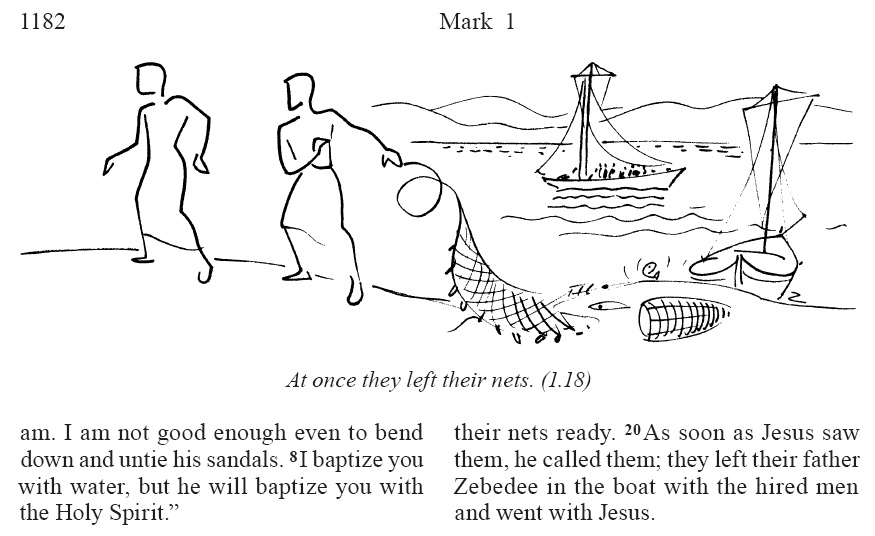
Current Column - Mark 1.31 (GNT)
\v 30 Simon's mother-in-law was sick in bed with a fever, and as soon as Jesus
arrived, he was told about her.
\v 31 He went to her, took her by the hand, and helped her up. The fever left
her, and she began to wait on them. \fig Took her by the hand, and...the fever
left her.|src="avnt017.tif" size="col" ref="1.31"\fig*
\p
\v 32 After the sun had set and evening had come ...
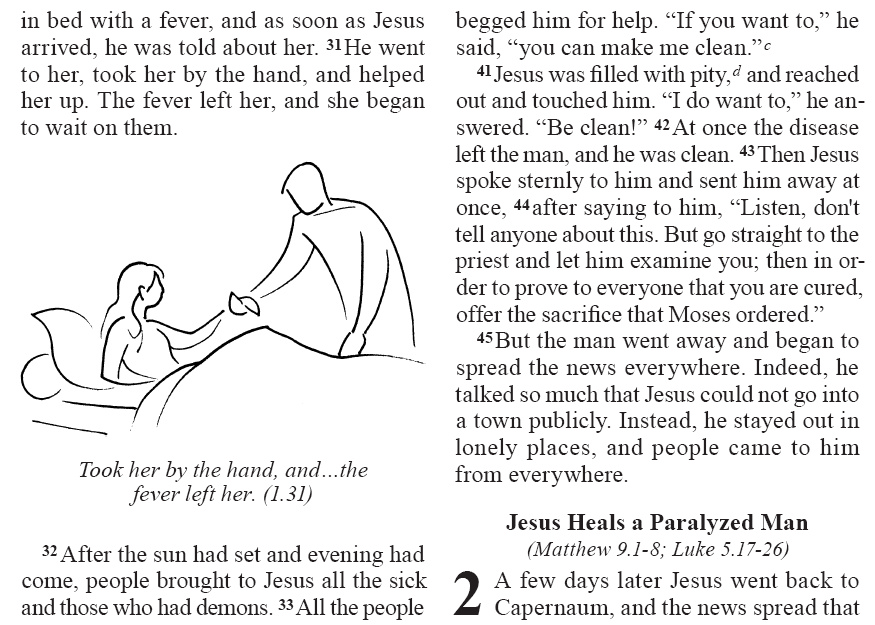
\ndx …\ndx*¶
- Syntax
\ndx_text...\ndx*- Type
character
- Added
1.0
- Use
Subject index entry.
Surround word(s) with this markup to indicate that it appears (or should appear) in the subject index.
\rb …\rb*¶
- Syntax
\rb_base text|gloss1:gloss2\rb*- Type
character
- Added
3.0
- Use
Ruby glossing.
Used to mark the base text being annotated with ruby characters.
Note
About Ruby
![]() See: https://www.w3.org/TR/ruby/
See: https://www.w3.org/TR/ruby/
Han characters: Chinese, Japanese, and Korean texts have some characters that they share in common. In Japanese these are called Kanji (literally “Han characters”). There are several thousand of these characters to learn. For new readers or readers new to the Biblical texts it may be very difficult for them to recognize what Chinese or Japanese word corresponds to the Han character(s) they are seeing.
Ruby glosses: In order to help these readers, some Bibles are printed with glosses using small phonetic characters (e.g. Japanese uses the hiragana alphabet) placed above the more symbolic Han characters to tell the reader how to pronounce the character. These phonetic characters are generically called “ruby glosses” or “rubies”. In Japanese this technique is called Furigana.
Following the syntax for word level attributes.
- gloss
Ruby glosses (default)
Use a colon:to separate multiple elements for glossing each of the characters within a base text phrase.
For example: If the base text being glossed is a phrase of two Han characters (B), then the ruby gloss text (gg) may contain two elements, one for glossing each of the base text characters making up the phrase.
\rb BB|gloss="gg:gg"\rb*
\rb BB|"gg:gg"\rb*
This syntax allows the decision to present glosses by phrase or by group to be made at the publication stage, rather than pre-determined during translation.
Parts of a phrase gloss may be left empty. In the example phrase below the second and fourth base characters are unglossed:
\rb BBBB|g1::g3:\rb*
Text and Formatting Samples
One Han character with a single ruby gloss.
\rb哀|あい\rb*
Two Han characters with a single ruby phrase gloss
\rb 話賄|はなはなし\rb*
Phrase gloss broken down into individual pieces by adding colons between ruby characters
\rb 話賄|はな:はなし\rb*
A character sequence which includes non-Han characters (hiragana), which are NOT glossed.
\rb 定ま|さだ:\rb*
An un-glossed character occurring between glossed characters in the “phrase”.
\rb 神の子|かみ::こ\rb*
Genesis 1.1-2 (Japanese Contemporary Bible - Biblica)
\p \v 1 まだ\rb 何|なに\rb*もなかった\rb 時|とき\rb*、\rb 神|かみ\rb*は
\rb 天|てん\rb*と\rb 地|ち\rb*を\rb 造|つく\rb*りました。
\v 2 \rb 地|ち\rb*は\rb 形|かたち\rb*も\rb 定|さだ\rb*まらず、\rb 闇|やみ\rb*に
\rb 包|つつ\rb*まれた\rb 水|みず\rb*の\rb 上|うえ\rb*を、さらに\rb 神|かみ\rb*の
\rb 霊|れい\rb*が\rb 覆|おお\rb*っていました。
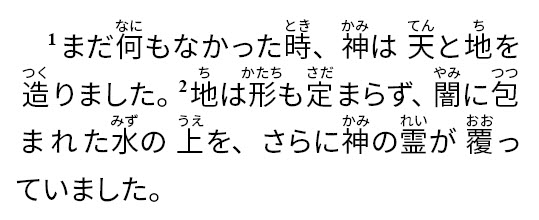
\pro …\pro*¶
- Syntax
\pro_text...\pro*- Type
character
- Added
2.0
- Deprecated
3.0
- Use
Pronunciation annotation.
Used for CJK text.
Deprecated (use is discouraged).
 Recommended alternate: \rb …\rb*.
Recommended alternate: \rb …\rb*.
\w …\w*¶
- Syntax
\w_text...\w*- Type
character
- Added
1.0
- Updated
3.0 (attributes)
- Use
Wordlist / glossary / dictionary entry.
Surround word(s) with this markup to indicate that it appears (or should appear) in the word list.
Following the syntax for word level attributes.
- lemma
Citation form for the term in the glossary (default)
\w gracious|lemma="grace"\w*
\w gracious|grace\w*
The unidentified attribute in the second example (above) is acceptable because lemma is defined as the default attribute for \w ...\w*.
- strong
Strong’s ID in the form H#### (Hebrew) or G#### (Greek)
\w gracious|lemma="grace" strong="G5485"\w*
\w gracious|strong="G5485"\w*
\w gracious|strong="H1234,G5485"\w*
Not \w gracious|G5485\w* (since strong is not default)
A strong’s ID augmentation identifier, if required, should be separated from the strong value by a colon :. An augmentation is a method of extending Strong’s by aligning it to another lexicon (e.g. Brown-Driver-Briggs). This requires dividing some words into two or more separate words.
\w gracious|strong="G5485:a"\w*
There are instances where more than one word may need to be included within \w …\w* because of how Hebrew and Greek use word repetition - e.g. for a superlative. Exodus 29:37 repeats the word ‘holy’ as the superlative form.
\w most holy|strong="H6944,H6944"\w*
- srcloc
Location of the word in the source text; Example: GNT version 5 text, book 51, chapter 1, verse 2, word 1.
\w gracious|lemma="grace" srcloc="gnt5:51.1.2.1"\w*
\wa …\wa*¶
- Syntax
\wa_text...\wa*- Type
character
- Added
3.0
- Use
Aramaic word list entry.